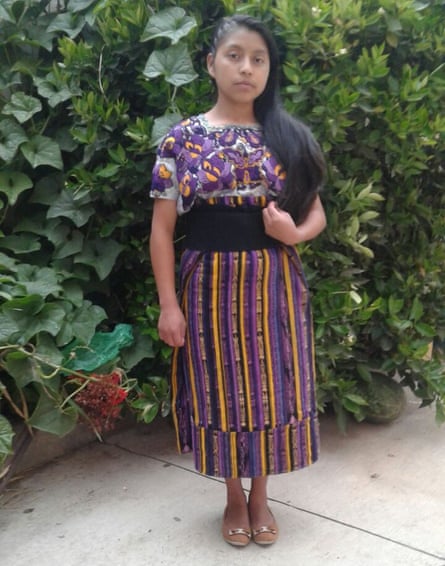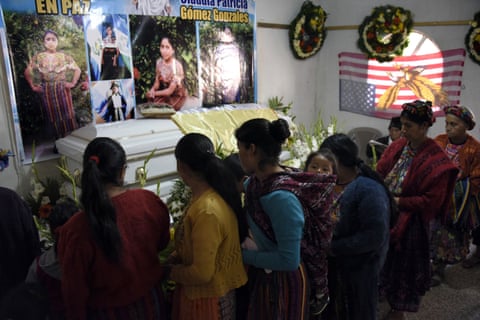Every Monday morning, after their two youngest daughters go to school, Gilberto Gómez and Lidia González trek to a brightly colored hillside cemetery to lay fresh flowers at their eldest daughter’s grave.
“Claudia Patricia Gómez González died in the United States on 23 May 2018 searching for the American dream … your death has left an emptiness in our home”, reads the engraving on the tombstone.
Claudia, a 20-year-old indigenous woman from western Guatemala, was shot in the head by a border patrol agent in Rio Bravo, Texas, just minutes after crossing the border.
A year on, and her parents still have no idea who killed her, or why.
“We’ve had no news from the American authorities, no visits, no phone calls. It’s a year since my daughter was killed and I want the same thing now as I did then: justice,” Mr Gómez, 40, told the Guardian.
San Juan Ostuncalco is a picturesque rural sprawl of mostly indigenous Mam communities scattered amid fertile mountains outside Guatemala’s second largest city, Quetzaltenango.
This region was the setting for multiple atrocities by government forces during the country’s 36-year civil war that left 200,000 civilians dead – most of them indigenous – and triggered a wave of forced migration to the US in the 1980s.
More recently, those refugees have been followed by a new generation of migrants, driven from home by economic hardship, climate change, government neglect and endemic corruption. In 2018, Guatemalans living abroad sent home a record $9.2bn in remittances, accounting for 11% of the country’s GDP.
Claudia Gómez graduated in 2016 with an accounting certificate, and the smart youngster hoped to continue studying but didn’t pass the tough entrance exam for a place at the country’s only public university. Then, in August 2017, her father was deported after several years working as an electrician in Atlanta. As a result, the family could not afford to send her to a private university. Keeping the family’s two younger children in school also became a struggle.

Gómez decided to migrate to try to fill the economic gap left by her father’s deportation.
She left home on 7 May 2018 with a local guide, or coyote, against the wishes of her mother and grandmother who worried about the dangerous overland passage through Mexico. “‘Don’t worry mama,’ she told me, ‘so many people make it. I’ll be fine, I’ll make it.’
“But she wasn’t fine, she never got to realize her dream of working in the United States,” said González.
Claudia arrived in Nuevo Laredo, Mexico, on the evening of 22 May 2018 – two weeks after leaving home – where she was taken to a so-called safe house full of Guatemalans waiting to cross the border to the US. From here, she phoned home; it’s a call her mother has replayed over and over in her head this past year.
“She sounded happy, excited because they were going to cross that night or in the morning. She told me not to worry, that she’d soon be at her aunt’s in Atlanta, and would call me then.”
Claudia crossed Rio Grande with five young men on 23 May around 11 or 11.30am, and entered a small abandoned building to wait for the next guide.
The Guardian spoke to several of these youngsters, who asked not to be named in order to protect the continuing investigation. They quickly left the building and hid among some bushes further uphill after catching sight of an armed patrol agent.

Over the next few minutes, two of the migrants ran, got over a nearby fence, and kept running. Shortly after, two more ran towards an abandoned trailer – leaving Claudia and one other – when they heard a single shot.
“I thought the agent had fired in the air to scare us, I went back a little way, but couldn’t see anything, so kept running,” one youngster told the Guardian.
A couple of minutes later, an agent entered the trailer. “He was very angry. He was holding his weapon with both hands, pointing it straight at us, and said [in Spanish] we had one opportunity to leave.”
The pair came out, were handcuffed, and led down to awaiting patrol cars where they saw numerous people in different uniforms including paramedics. The youngster who was with Claudia when she was shot was also detained.
Initially, the CBP said that a lone agent fired in self-defense after a group of undocumented migrants resisted arrest and attacked him with blunt objects, describing Claudia as one of the “assailants”.
But the official story changed after a live broadcast of the aftermath of the fatal incident by neighbor, Marta Martinez, went viral. In the video, filmed by Martinez on her cellphone, she is repeatedly heard asking agents why they shot a young woman. “Why did you kill that woman? You killed her!” Martinez is heard saying. “I saw you with the gun.”
Two days later, CBP issued another statement, which said a 15-year veteran of the border patrol had been “allegedly assaulted” and “rushed”, and did not mention blunt objects.

Another video filmed by Martinez, but not broadcast, was handed over to federal investigators.
The migrants interviewed by the Guardian denied having sticks or rocks, and said Claudia was unarmed, timid and scared.
The three detained men, who met Claudia and each other at the safe house in Nuevo Laredo, spent over five months locked up in various detention centers waiting to testify.
At the end of October last year, tired of incarceration, they opted to be deported home and return to testify in the US, if a criminal charge is brought against the agent. The FBI investigation remains ongoing, and agents have been in contact with the witnesses, but the family have heard nothing.
The FBI did not respond to the Guardian’s request for an update on the case, nor did CBP.
A Guardian investigation published three weeks before Gómez was killed found that CBP agents used deadly force on at least 97 people since 2003. Six Guatemalan children and adolescents have died trying to reach the US since Gómez died in May 2018.
A year on, and her parents want answers – and justice.
“We still don’t know the name of the person who killed my daughter. We don’t know if he’s in jail or still working. We don’t know why he killed her,” said González.
Mr Gómez added: “We pray to god that the guilty man is sent to jail and pays for what he did. And we hope that the Americans stop killing migrants.”
